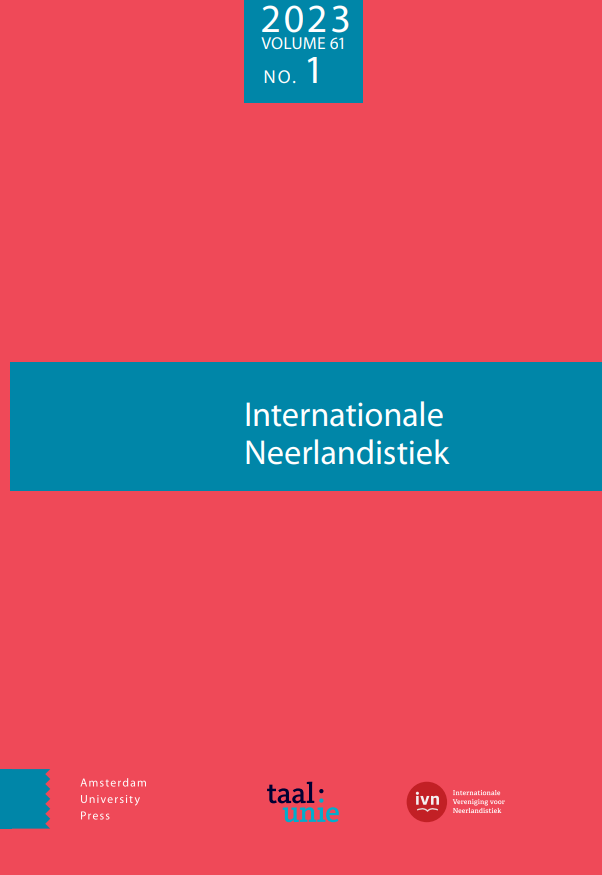-
oa De invloed van het Nederlands op contacttalen in zeventiende-eeuws Taiwan1
- Amsterdam University Press
- Source: Internationale Neerlandistiek, Volume 59, Issue 2, May 2021, p. 115 - 135
-
- 01 May 2021
Abstract
In 1624, the Dutch East India Company (VOC) arrived on the island of Taiwan and established a trading post there, which would continue to function until 1662. During this period, Dutch missionaries came to the island with the intention of proselytizing the indigenous Formosan peoples. They built churches and schools and translated Gospels and catechisms into Formosan languages. Over time, language policy changed and there was a concerted effort to teach the indigenous people Dutch. Many Chinese, including traders, fishermen and farmers, also went to Taiwan in this period. To support its investment on the island, the VOC implemented a system of tax-farming among the Chinese, who eventually numbered some 50,000. In this article, an attempt is made to analyse the linguistic consequences of contact between the Dutch on the one hand and the Formosans and Chinese on the other hand. The first of these is that the Dutch taught Formosans to write using a modified Roman script. The Formosans continued to use this script long after the Dutch had been expelled in 1662. Second, Dutch missionaries translated texts into two Formosan languages, Siraya and Favorlang. Since 1662, both languages have died out and so the Dutch texts are among the few sources which allow scholars to study these languages. Third, because of contact with Chinese tax-farmers, at least two Dutch loanwords have been adopted by local Sinitic varieties, both of which function as productive morphemes. Furthermore, one of these words has its own Chinese character. In short, this article aims to illustrate how contact with Dutch influenced other languages in Taiwan and thus to contribute to our understanding of the consequences of contact between Dutch and other languages in East Asia.
Samenvatting
In 1624 arriveerde de Verenigde Oost-Indische Compagnie (VOC) op het eiland Taiwan en vestigde daar een handelspost, Fort Zeelandia, die tot 1662 zou blijven functioneren. Het hoofddoel van de VOC was het drijven van handel met China en eveneens het oprichten van een stophaven voor schepen onderweg tussen Batavia en de VOC-handelsposten in Japan (Hirado 1609-41; Decima vanaf 1641). In hun kielzog kwamen Nederlandse missionarissen in deze periode naar het eiland met de bedoeling, de inheemse Formosanen te bekeren tot het protestantisme. De VOC bouwde kerken en scholen en de missionarissen vertaalden Bijbelteksten en catechismussen in Formosaanse talen, die behoren tot de Austronesische taalfamilie, waartoe o.a. het Maleis en het Tagalog eveneens behoren. In de loop van de tijd veranderde het taalbeleid van de VOC en werd er een gezamenlijke inspanning geleverd om de inheemse bevolking Nederlands te leren. In 1649 stonden er 315 dorpen onder het gezag van de VOC, die 68.675 inwoners telden. Vóór de Nederlandse periode woonden er zo’n 10.000 Chinezen op Taiwan, waarvan de meerderheid handelaren, vissers, piraten en smokkelaars was. In die periode gingen veel andere Chinezen, waaronder veel landarbeiders, naar het eiland. Zij kwamen vooral uit de zuidelijke Chinese provincies Fujian en Guangdong. Om haar investeringen op het eiland te ondersteunen, voerde de VOC een pachtsysteem onder de Chinezen in.
In dit artikel wordt een poging gedaan om de gevolgen betreffende de taal te analyseren van het contact tussen de Nederlandse taal enerzijds en de Formosaanse talen en regionale Sinitische talen anderzijds. Drie gevolgen zullen specifiek onder de loep worden genomen. Ten eerste hebben de Nederlandse missionarissen Formosanen geleerd met Latijnse letters te schrijven. Na 1662 bleven de Formosanen dit schriftsysteem om praktische redenen gebruiken tot in de negentiende eeuw. Ten tweede vertaalden de Nederlandse missionarissen christelijke teksten in twee Formosaanse talen, het Siraya en het Favorlangs, die inmiddels zijn uitgestorven. Daarom vormen deze teksten een belangrijke bron voor de hedendaagse studie van die talen, en ook voor de nakomelingen van deze Formosanen die nu proberen het gebruik van het Siraya nieuw leven in te blazen. Ten derde bestaat er als gevolg van het contact tussen de Nederlanders en Chinese pachters een klein aantal toponiemen en leenwoorden, en een nieuw ‘dialectkarakter’ in twee Sinitische talen opgenomen: het Mandarijn en het Taiwanees Zuidelijk Min ofwel het Taiwanees Hokkien. Kortom, dit artikel doet een poging om een aantal van de gevolgen betreffende de taal van de Nederlandse kolonisatie van Taiwan in de zeventiende eeuw aan te tonen en daarmee iets bij te dragen aan onze kennis van de invloed van het Nederlands buiten de Lage Landen, vooral in Oost-Azië.


